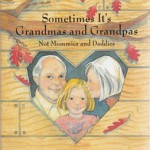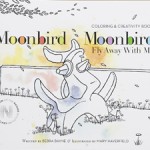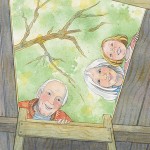 Give a warm welcome to Mary Haverfield, this month’s picture book illustrator. She has a lot of information to share. 😀
Give a warm welcome to Mary Haverfield, this month’s picture book illustrator. She has a lot of information to share. 😀
When did you get started illustrating for children? What did you do before?
I studied illustrating for advertising, in college at the University of Houston. I did what used to be called paste-up for a design firm in Houston to pay my way through school. This was long before computers. When we moved to CA I continued doing paste-up at an ad agency in Los Angeles while I attended classes at the Art Center College of Design at night. When the ad agency job ended I freelanced all over LA for six years, while my husband was learning photography. The evening classes at Art Center kept my illustration hopes alive. We moved to Dallas in the early 80’s when Pat was hired to work as an advertising photographer on staff at a large studio here. At that point I decided, no more paste up jobs. For a year or two design firms and ad agencies hired me to create illustrations for magazines, brochures, and greeting card companies. It was during this time that I realized I needed a more definite style, and I wanted to pursue children’s illustration, not advertising. I took a year off and developed a more distinctive style by illustrating the classic story of Jack in the Beanstalk. By the end of that time I had a new portfolio of 11 illustrations. Four were in black and white using graphite pencil. The rest were in watercolor, gouache, and colored pencil. I began to show this work around town and soon met a local printer who wanted to produce an accordion fold promo piece with me, using five of my new illustrations. We got a paper company, a separator, and a calligrapher involved and we all used that piece for promotion. Soon after this piece was printed Pat and I traveled to NYC so I could show my work to publishers. Since then the bulk of my work has been in children’s publishing
Tell us a little bit about the recent book you wrote and illustrated, Sometimes It’s Grandmas & Grandpas: Not Mommies & Daddies.
 Abbeville Press hired me to illustrate this book last year. The author is a woman in CT named Gayle Burn.
Abbeville Press hired me to illustrate this book last year. The author is a woman in CT named Gayle Burn.
The book is about a little girl 5 or 6 years old, being raised by her grandparents. It’s told from the child’s perspective. She’s happy with grandma and grandpa and feels well loved, but she’s begun to wonder why she doesn’t have a mommy and daddy. Gayle is raising her own grandchild. She found there were plenty of books and support groups for adults in this situation but none for children, especially small children. Abbeville and Gayle found me on the picturbookartists.org website and especially liked a piece I had done of our goddaughter Carolina, who was the same age as Gayle’s little girl.
You also worked on an activity book. Can you tell us about what that was like?
 “Moonbird, Moonbird Fly Away With Me” was a true labor of love.
“Moonbird, Moonbird Fly Away With Me” was a true labor of love.
I am a member of a small but talented critique group here in Dallas. One of the members Bebra Bayne, is a wonderful writer who works a lot with the Nasher Sculpture Center. We had an idea for a children’s book in 2008. The Center rejected our original idea but suggested a coloring book. Bebra and I began brainstorming immediately. A few weeks later we presented a sample manuscript, along with 3 illustrated spreads. They gave us permission to develop a full book dummy. We did, they approved, and to our surprise added to it. Our book went from 32 pages and a modest 8” by 10”, to 48 pages at 9” x 12”! This book allows children the opportunity to take a few of these great sculptures home!
What are you working on right now? Do you have any other books or art projects you’d like to talk about?
I’m working on launching a blog and hope to have it up and running within the month.
Do you do non-children’s book art (licensing, fine art, etc.) or art just for fun? Is that art similar or different from your children’s book art?
No and Yes! No I have not sold any art for licensing. I would like to but don’t know how well my work would lend itself to that.
Yes, I’ve sold a few original spreads from my books. I have also sold a few contemporary style paintings. These paintings were not similar to my children’s book art at all. They’re all done in acrylic paint, non-representational, from 3’ x 4’, up to 4’ x 8’.
Do you illustrate full time? If not, what else do you do?
I also do school and library visits, in which I talk about my books and the process of creating picture books. Most of my presentations are to the elementary grades, however I have 3 or 4 different programs I can deliver depending on the age of the kids and the needs of the teachers, or librarians. I have spoken to groups from pre-school to college age.
I still write and would love to find another book I both wrote and illustrated on bookstore shelves one day.
Besides illustrating and painting, I sometimes help my husband Pat, a food and still life photographer and director. www.pathaverfield.com
When you illustrate a picture book how do you decide what scenes and details to draw?
This is one of my favorite parts of the whole process. I read the story several times. Next I do tiny thumbnails so I can see at a glance the action in the story and how the book will flow. When this tiny “book” makes sense, I enlarge it and embellish until I have a more complete dummy, usually about half size. Seeing each book as a little movie in my mind, and then constructing these dummies helps me to choose which scenes will be the most interesting to illustrate and which are most important to keep the story moving.
When illustrating picture books do you include a visual storyline not mentioned by the text or include animals or people you know?
Yes, quite often. For instance in the case of this last book “Sometimes…” I felt the author didn’t give me enough locations to work with. She talked mostly about the child and the grandmother hugging and I needed more than that.  I decided that the grandfather could be building a tree house for the girl. I pictured him gathering materials, reading a book about tree houses, and finally building one with the girl as the story unfolds.
I decided that the grandfather could be building a tree house for the girl. I pictured him gathering materials, reading a book about tree houses, and finally building one with the girl as the story unfolds.
Fortunately everyone liked this idea and I now had many interesting props and points of view to explore.
The use of detailed borders is another device I often use. With borders I can enhance the design, mood, and atmosphere of each scene, suggest time of day, and seasons of the year. I have even introduced characters in the borders, not mentioned in the manuscript. Reading to my own child and many others, I’ve found they love the details. If during the 3rd or 4th time a book is read to a child, they can discover a new detail for the first time? That’s magic for me
Can you explain your art process? (please include a URL link to any visuals you may have on a blog or web site)
My process is very low tech I’m afraid. After the dummy is approved on a book project, I do all the sketches with pencil, full size. I do very detailed and finished sketches at this stage for two reasons. One: I want the clients to see exactly what I’m proposing. And two: Watercolor illustrations have to be well planned out before I paint. This is where I decide on colors, avoid over painting, and any number of other mistakes I’m prone to make. As I work on the sketches I tape them, in order, to a long wall in my studio. From there I can
stand back and see at once how things are flowing and fitting together. I study them for days, weeks, adding and subtracting details, and asking myself questions. Does the main character’s clothing stay the same in this scene as in the one before? Where is the light coming from in this scene? Can I put a clue on this page that relates to what’s coming on the next? Stuff like that.
When all sketches are approved I transfer the sketches to 300 lb., Fabriano Artistico WC paper. Extra white. They are transferred by hand using 2H pencils and a truly ancient
Art-o-graph. During this process I fine-tune the drawing, and adjust size relationships, etc.
Next I mask off the edges with blue painter’s tape and start painting. Lightly at first, slowly building up layers of paint until the saturation and depth is working for me. Next I go into each illustration with a very sharp brown Color-erase pencil. Heavier lines help define the foreground. Lighter or nonexistent lines establish distance. Next I go back to painting, laying down my darkest values and shadows, playing with color and value to bring the piece alive. The final step requires a bit of white gouache. Pure white to brighten or add highlights, and white mixed with watercolor where I need to paint over mistakes, reinforce shapes, or make minor changes
Do you have a favorite color or palette?
Yes. I developed my basic palette working on Jack and the Beanstalk all those year’s ago. For the most part I use the same colors today. I find I also wear them and decorate my house with them. How weird is that?
What is your favorite medium to work in? Have you always worked in this media? If not, why did you switch?
 I’ve always used a combination of watercolor, gouache, and colored pencil for my illustration work. I flirted with Dr. Martin’s dyes in college and early in my career, but they proved difficult to reproduce, and were too harsh for what I wanted to do in children’s illustration. I’ve also used some collage.
I’ve always used a combination of watercolor, gouache, and colored pencil for my illustration work. I flirted with Dr. Martin’s dyes in college and early in my career, but they proved difficult to reproduce, and were too harsh for what I wanted to do in children’s illustration. I’ve also used some collage.
For large paintings I started with acrylics years ago mostly out of necessity. My first “studios” were a spare bedroom, a tiny attic, or our garage. Acrylics have no fumes, dry faster, and are easier to clean up.
Did you always want to be an artist when you grew up?
Yes. I was always drawing apparently. In Jr. high an art teacher strongly encouraged me to study art. I was thrilled. Then my high school art teacher, who was him self a working artist, taught me the many ways a person could actually make a living in the arts. We were living in southern New Jersey and he took us on regular field trips to NYC and Philadelphia. We saw all those great museums as well as a few galleries every year because of him. I also worked on the HS yearbook where I began learning about the graphic arts and preparing art for a printer. I honestly never thought of any other career path.
Do you use models/source pictures or do you draw from your memory/imagination?
Both. I do research on line. I shoot pictures myself and often enlist everyone I know to model for me. I look at other illustrators work constantly, and doodle and sketch as much as possible. I’m working to stylize my work more and more.
If you could be anything other than an artist, what would you be?
Someone who works outside with plants, like a landscape architect or even basic yard maintenance? When I’ve been “chained” to my drawing board for long periods I often dream of a job like that.
What gets you through an illustration when you’re stuck for inspiration?
A long walk always helps a lot. A trip to the library! I also cruise the net looking at my hero’s (read: illustrators I admire) web sites and blogs, I look for new books by great illustrators on Amazon. Listening to recorded books or music helps too. If none of the above does the trick, I stop working on that particular piece and switch to another. Sometimes it’s best to pick up the phone and talk to my editor and/or the author of the piece to get their thoughts. A good editor can be a fountain of inspiration and information.
What book do you remember from when you were young? (list one or multiple books)
The Wind in the Willows, Winnie the Pooh (illustrated by E. H. Shepard), anything by Dr. Seuss, all things Disney, Peter Pan (The original. Not so much Disney), a book of poetry we had by Robert Louis Stevenson
Is there a children’s book illustrator whose work you gravitate towards in the bookstore now? (list one or multiple illustrators)
Soooooooo many! David Small Lisbeth Zwerger Oliver Jeffers
Chris Van Allsburg Allen Say Raul Colon
William Joyce P. J. Lynch Jane Dyer
David Wiesner Mary Grandpre Brian Selznick
Brian Lies Etienne Delessert Jerry Pinkney
Maurice Sendak Tomie DePaola Paul O. Zelinsky …just to name a few.
If you could illustrate any writer’s new work, who would it be?
My own!!
Who do you want to be when you ‘grow up’?
A children’s illustrator and author, who also paints fantastic fine art pieces and sells both, in bookstores and galleries and beyond!


 RSS - Posts
RSS - Posts
What a lovely & informative interview. Beautiful work! Thanks to both of you.
Great work, should be very proud of yourself.